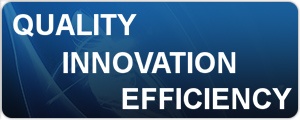Ruhrpumpen’s Fire Campus
NFPA 20 Section 4.10.1 establishes a fundamental design rule that a centrifugal fire pump must be selected so that the largest single system demand does not exceed 150 percent of the pump’s rated flow. This sizing limitation exists because fire pumps are certified and tested to operate safely up to 150 percent of their rated capacity, but not beyond it. By ensuring that no connected sprinkler, monitor, hydrant, or deluge system requires more water than the pump can deliver at this upper performance limit, designers avoid conditions that would otherwise overload the pump, starve critical fire protection systems, or cause pump overheating, cavitation, or mechanical instability. For example, if the greatest fire demand is 3,000 gpm, the selected pump must be rated at least 2,000 gpm so that its 150 percent rating matches or exceeds that demand.

UL 448, the performance standard for centrifugal fire pumps, directly supports this NFPA requirement by requiring pumps to demonstrate stable, safe operation at 150 percent of their rated flow. During UL certification testing, pumps must provide at least 65 percent of rated pressure at 150 percent of rated flow while avoiding excessive vibration, overheating, or mechanical failure. Additional overload testing ensures the pump shaft, bearings, casing, and driver remain within acceptable temperature and stress limits. UL also requires stability and run-duration tests at 150 percent flow so that the pump can sustain operation at this point long enough to meet the functional needs of a fire event. These requirements confirm that pumps can safely operate at the exact limit NFPA uses as a design constraint.
FM Approval Standard 1311 contains similar performance and endurance requirements. FM requires pumps to deliver both rated flow and 150 percent of rated flow while maintaining a minimum of 65 percent of rated pressure. Pumps must also pass run testing at shutoff, 100 percent, and 150 percent capacities without overheating, exhibiting mechanical distress, or showing signs of hydraulic instability. FM adds long-duration endurance tests to verify the pump can sustain overload conditions without bearing degradation, seal failure, or fatigue cracking. These provisions reinforce the NFPA design rule by proving that approved pumps can reliably operate at the upper end of their certified performance envelope.
Together, NFPA 20, UL 448, and FM 1311 form a consistent framework: NFPA 20 dictates that system designers must limit the maximum required flow to no more than 150 percent of the pump’s rated capacity, while UL 448 and FM 1311 validate that fire pumps are physically capable of safely delivering this performance.
FireWatch: World Updates
The Ichthys LNG onshore facility, operated by Inpex, is located at Bladin Point near Darwin in the Northern Territory of Australia and is regulated by the Northern Territory Environment Protection Authority (NT EPA) under an Environment Protection Licence issued in accordance with the Waste Management and Pollution Control Act. In recent months, the facility has faced heightened scrutiny after Inpex admitted in October 2025 to errors in its calculation and reporting of volatile organic compound (VOC) emissions, including benzene, toluene, ethylbenzene, and xylene. Following this disclosure, the NT EPA launched an immediate investigation, and additional concerns surfaced as workers reported exposure to toxic chemicals, oil spills, and inadequate management responses. Despite these issues, the Northern Territory’s Chief Health Officer has stated that current monitoring shows no evidence of increased health risks to the community.
On 10 November 2025 at approximately 3:10 PM, a fire broke out inside the Tank 2 dehydration bed at the Bladin Point Ichthys facility. This area of the process plant, which forms part of the gas-processing train, contains hydrocarbon gases, molecular sieve dehydration media, high operating temperatures, and high-pressure systems. Any fire or thermal runaway in such a unit is considered a high-hazard scenario requiring high-capacity fixed firewater protection, including dedicated fire water ring mains and both diesel and electric fire-water pumps capable of delivering large volumes of water. According to Inpex, the incident was managed in accordance with established emergency response protocols and was quickly extinguished. The rapid control of the fire strongly suggests that the fire-water system—including its pumps—operated effectively, delivering sufficient pressure and flow for deluge cooling or fire-monitor operation.
No injuries were reported, and both Inpex and regulators stated that the fire caused no environmental damage. NT WorkSafe was notified of the event, and the NT EPA began assessing whether any environmental harm may have occurred. Inpex publicly reiterated its commitment to cooperate fully with all regulatory authorities. As part of such investigations, regulators typically evaluate the performance of critical emergency systems, including fire-water pumps, reviewing maintenance records, pressure-test logs, system reliability, and whether the pumps delivered adequate flow rates to the affected zone.
At facilities such as Ichthys LNG, emergency response protocols depend heavily on the proper operation of fire-water pumps. These pumps must start automatically when header pressure drops, remain operable during total power loss through diesel-driven units, and provide N+1 redundancy so that protection remains available even if a pump fails. Given the speed at which the Tank 2 fire was extinguished, it is likely that the pumps auto-started as designed, maintained stable system pressure without cavitation or trip events, and provided the necessary flow to suppress the fire and prevent its escalation to adjacent equipment.
Several underlying issues contextualize the incident. An internal review at Inpex showed that emissions reported for the 2023–24 financial year were significantly lower than recalculated values: total VOCs were originally reported as 1,618.83 tonnes compared to a recalculated 3,562.3 tonnes; benzene was reported at 4.12 tonnes versus a recalculated 556.9 tonnes; and toluene was reported at 5.05 tonnes compared to a recalculated 569.8 tonnes. Inpex stated that these discrepancies were unintentional and that emissions from previous years were being reviewed, further noting that ongoing air-quality monitoring continued to show emission levels within government guidelines. Worker safety concerns have also emerged, with employees reporting chemical exposure, oil-related burns, and a culture of disregarding environmental or safety alarms. Some workers claimed that critical pollution-control equipment, such as acid gas incinerators, had been offline at times.
Compounding these concerns, a significant oil spill occurred in October 2025, during which approximately 36,000 litres of heating-medium oil leaked at the facility. Some of this oil entered stormwater drains and nearby mangrove areas, although testing reportedly did not detect contamination beyond the site’s boundaries. In terms of community health, the NT Chief Health Officer maintains that even with revised emissions data, no increased risk has been identified through existing monitoring programs. The NT EPA continues to work with health authorities to evaluate long-term risks associated with the facility’s operations.
From a technical and regulatory perspective, fire-water pumps at LNG facilities such as Ichthys must comply with recognized design standards, including NFPA 20 (Installation of Stationary Pumps for Fire Protection) and AS 2941 (Fixed Fire Protection Installations). These standards require at least two pumps—typically one electric and one diesel—automatic start on demand, continued operability during plant shutdowns, and routine weekly or monthly testing. A fire in a dehydration unit, such as the one experienced at Tank 2, is precisely the type of event these standards are intended to address. The rapid containment of the incident reinforces the likelihood that the fire-water pumps and associated fire-protection systems functioned as required, supplying the water necessary for deluge cooling, fire suppression, and preventing escalation to adjacent process units.
The incident presents several broader implications and risks. From a regulatory standpoint, the fire adds to the growing pressure on Inpex amid previous environmental issues such as the oil spill and emissions under-reporting. Reputational risk is also significant, as worker complaints and ongoing investigations could damage the company’s standing locally and among broader stakeholders. Health and environmental concerns, particularly the dramatic under-reporting of benzene—a known carcinogen—raise long-term risk considerations even if immediate exposure appears low. Operationally, a fire in a dehydration unit may indicate potential deficiencies in maintenance or process safety, suggesting systemic vulnerabilities that could pose future threats to safety, reliability, and business continuity.
Ruhrpumpen's Spotlight
The supplied fire pump system integrates both horizontal and vertical equipment into a single, comprehensive solution designed to deliver reliable performance in critical industrial applications and high-corrosion marine environments. The main horizontal pumps are model ZW 6×5×12 (F), a BB1-type split-case unit certified UL Listed and FM Approved, offering 1500 GPM and 150 psi operating pressure. They feature a casing made of A216 WCB carbon steel, an A351 CF8M stainless steel impeller, and wear rings in Super Duplex A890 Gr. 1B, ensuring mechanical strength and long-term durability. Each pump is powered by a Clarke JU4H-UF34 diesel engine rated at 115 HP at 3000 RPM, equipped with FM-approved radiator cooling, NFPA 20 alarm and control systems, and redundant batteries for maximum availability.
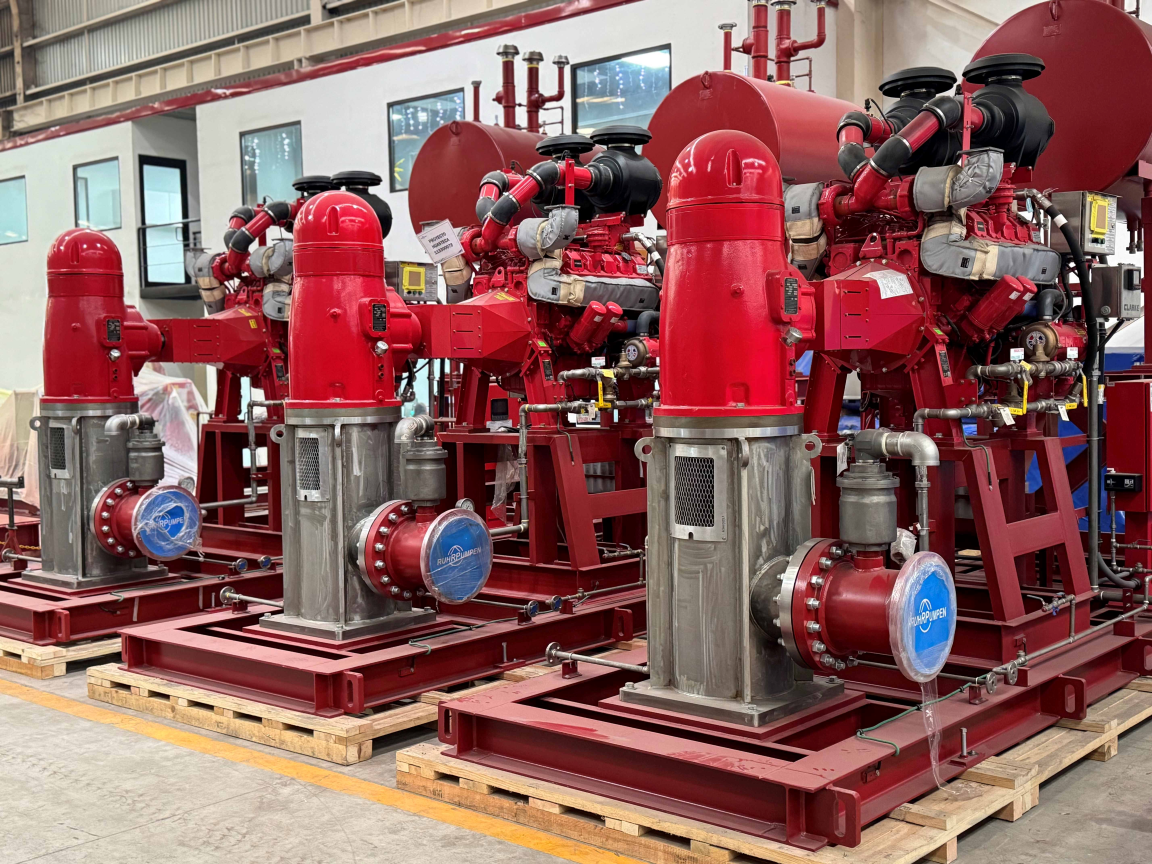
Complementing these units, the system includes vertical turbine pumps model 20C-600, VS1 type, fully manufactured in Duplex stainless steel to withstand seawater and corrosive conditions. These pumps feature two hydraulic stages, 20-inch bowls, 12-inch flanged column with a total length of 10.58 feet, and Duplex shafts lubricated by product. They are driven by Clarke DS0H-UFAA68 diesel engines rated at 587 HP at 1760 RPM, equipped with FM-approved marine cooling loops, 316 stainless steel silencers and spark arrestors, tropicalized control systems, and 24-V NiCd battery banks. The package also includes reinforced marine gearheads, corrosion-protected drive shafts, and Super Duplex accessories that ensure reliable performance even under harsh marine exposure.
The scope also includes a vertical auxiliary pump model 6A-6 with six stages, entirely built in Duplex, featuring a 4-inch flanged column, a 1-inch shaft, and a 4” 150# RF spool piece. This pump is powered by a 20 HP, 3600 RPM, VHS TEFC IP56 electric motor with Class H insulation, suitable for continuous duty in demanding environments. To maintain system pressure, a multistage jockey pump model WDM/VSE 10-10-100 is included, delivering 62 GPM at 142 psi and driven by a 10 HP, 440-V motor. It is complemented by a UL/FM Cla-Val 55L pressure relief valve to ensure stable operation across the network.

All equipment is controlled by advanced UL/FM-certified controllers. The main pumps are equipped with Tornatech GPD controllers housed in NEMA 4X stainless steel enclosures, featuring NiCd battery chargers, full NFPA 20 alarm packages, Modbus remote monitoring capability, and protection features tailored for marine environments. The jockey pump is managed by a Tornatech JPLT controller with a ViZiTouch interface and protections against phase failure, overload, and unsuccessful starts. The system also includes double-wall UL-142 diesel tanks, certified leak sensors, 316 stainless steel flame arresters, Super Duplex Cla-Val valves and strainers, and Rosemount 2051G instrumentation built with corrosion-resistant alloys. All pumps are supplied on common bases coated with C5-M marine-grade protective paint for maximum durability in severe environments.
The result is an integrated fire pump solution that combines flow, pressure, hydraulic efficiency, and superior corrosion resistance, supported by mission-critical diesel engines and certified controllers. This system provides a robust and reliable platform designed to ensure operational continuity in industrial facilities where fire protection is a strategic priority.
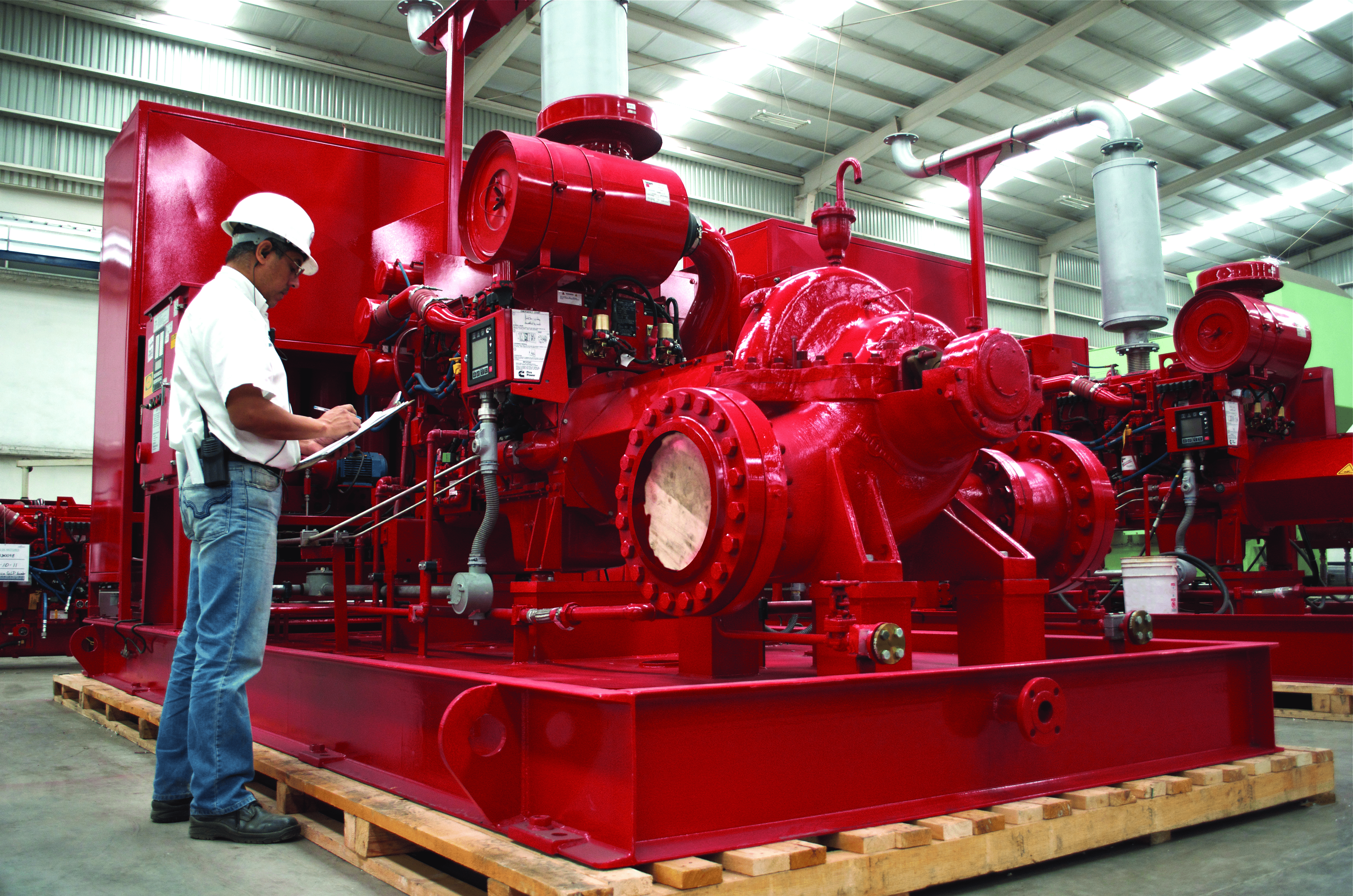

Are you looking for Fire Pumps and Systems to cover your pumping needs? Let Ruhrpumpen help solve your pumping demands.
Contact us now by clicking here.
Discover fully engineered systems that deliver performance, reliability, and peace of mind, all from a single source supplier.
Following the successful delivery of a complete system for a major gas project in Peru, Ruhrpumpen has once again proven its capability to design and supply integrated solutions tailored for hydrocarbon and water handling applications.
We go beyond individual pumps, we design and deliver complete engineered systems that integrate performance, reliability, and efficiency from start to finish.
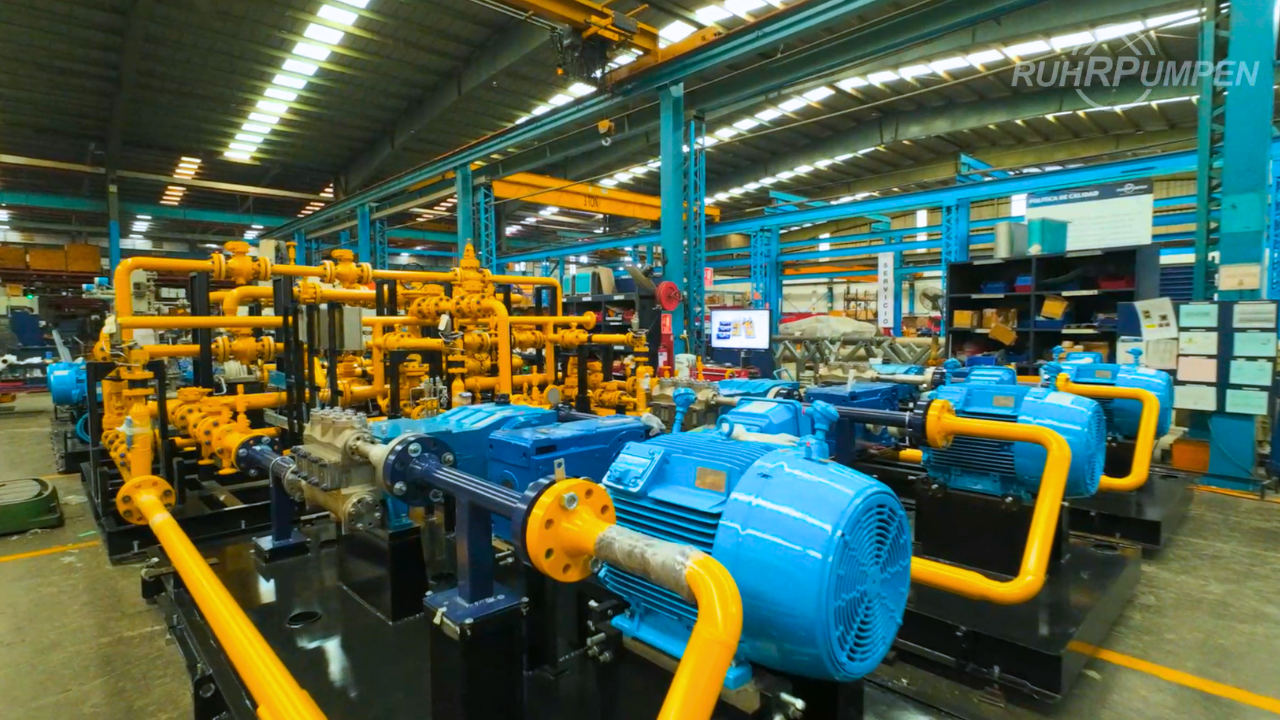
Following the successful delivery of an engineered system for a major gas generation project in Peru, Ruhrpumpen has now provided an additional package of equipment designed for hydrocarbon and water handling applications.
This project includes the supply of RDPT pumps (16 m³/h, 86 kW) and SCE pumps (26 m³/h, 20.41 kW), systems specifically engineered to support separation processes and ensure safe, continuous production under demanding operating conditions.
The final system verification was successfully completed in the presence of the client, reaffirming the quality, performance, and reliability that define Ruhrpumpen’s engineered solutions.
Watch the whole video by clicking here: Youtube Video
Our new offices in Monterrey represent growth, innovation, and the spirit that drives Ruhrpumpen forward.
During the summer of 2025, Ruhrpumpen proudly relocated its corporate office to the modern BH LifeWork building, located in Monterrey, Nuevo León, Mexico.

Monterrey is not only our hometown — it is also one of the most important industrial hubs in Latin America. Known for its solid infrastructure, highly skilled talent, and relentless drive for innovation, this city perfectly embodies the spirit of Ruhrpumpen: hard work, global vision, and an enduring commitment to excellence.
Our new home reflects that same commitment. It is a space designed to foster collaboration, enhance efficiency, and elevate the overall experience — a place that inspires us to continue developing pumping solutions that move the world.

This move represents more than a change of address. It’s a natural step in our evolution and a reaffirmation of who we are: a global team united by shared passion and purpose.
Watch the whole video by clicking here: Youtube Video
At Ruhrpumpen, being the Supplier of Choice means more than delivering pumps; it means earning trust through operational excellence, reliability, and proven performance.
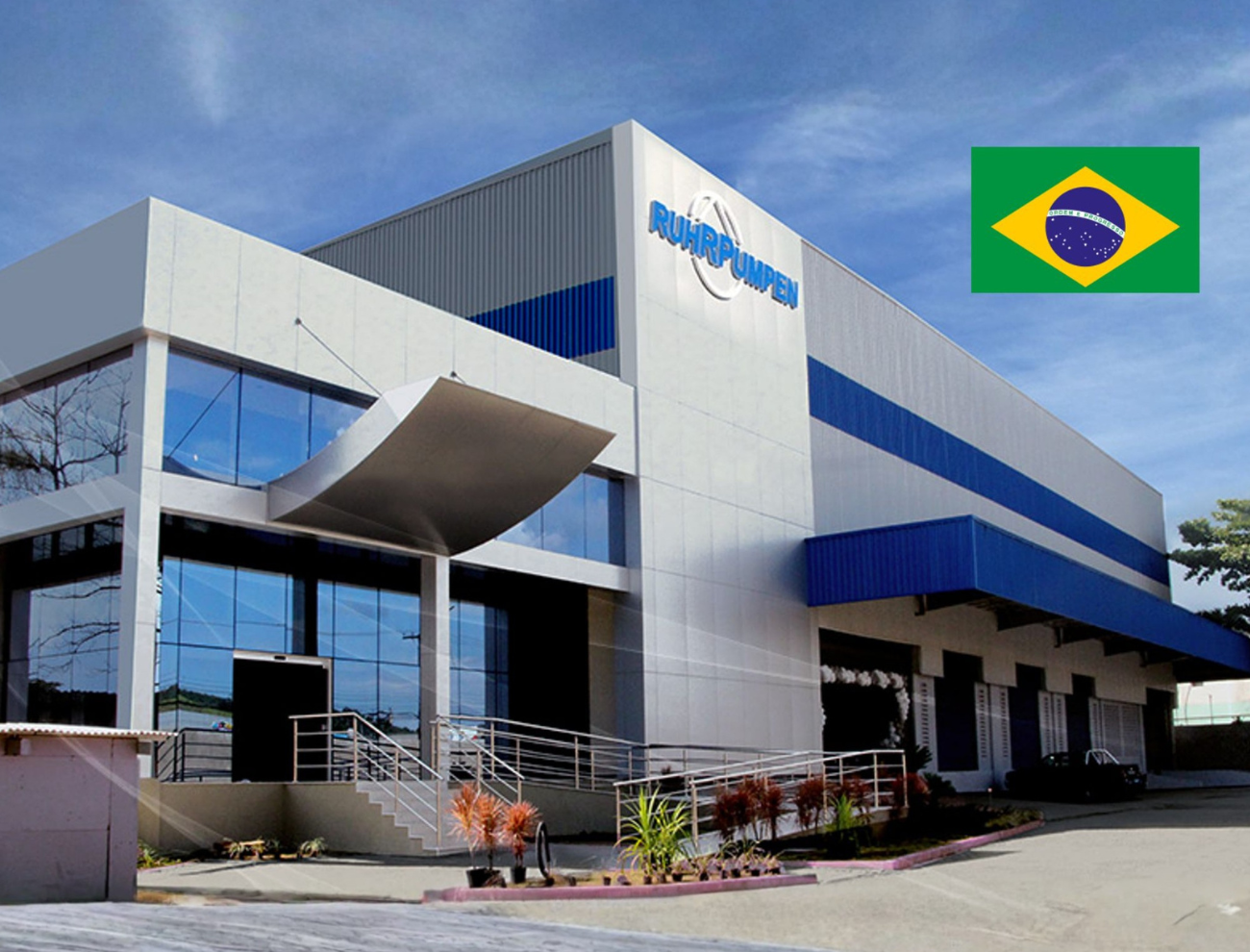
That commitment was reaffirmed as Petrobras, one of the world’s leading energy companies, completed a comprehensive audit of Ruhrpumpen do Brasil, achieving 100% IQF (Supplier Quality Indicator) with zero non-conformities, a perfect score that confirms Ruhrpumpen do Brasil’s full compliance with Petrobras’ strict quality standards.
The audit thoroughly reviewed all critical manufacturing and quality processes, including welding, assembly, testing, painting, calibration, documentation, and traceability, confirming full compliance with Petrobras’ technical and contractual requirements.
The Petrobras auditors recognized Ruhrpumpen’s strong technical capability, well-structured organization, and the professionalism of its team throughout the audit process.
The facility’s layout, documentation system, and safety culture were also highlighted as examples of excellence.
This milestone further strengthens Ruhrpumpen’s reputation as the Supplier of Choice in the oil and gas industry. It reflects our ongoing mission to deliver engineered solutions that combine reliability, safety, and performance, solutions that our customers trust to keep their operations running efficiently every day.
With this successful Petrobras audit, Ruhrpumpen once again demonstrates that every Ruhrpumpen system is built on processes that have been verified, tested, and approved by one of the most demanding companies in the world.
Looking for all this in a supplier?
You don’t need to look any further. Contact us today.
